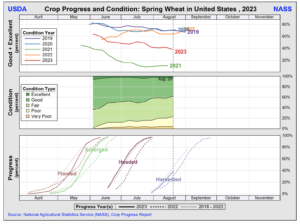Agriculture Secretary Brooke Rollins said on Tuesday that the Trump administration will announce a 'bridge payment' for farmers next week that is designed to provide short-term relief while longer trade…
U.S. Corn Ratings Decline, Soybeans Steady, While Spring Wheat Conditions Drop
Reuters writer Mark Weinraub reported yesterday that, “The condition of the U.S. spring wheat crop dropped in the latest week, the government said on Monday, as forecasts for hot and dry weather continued in the northern Plains this week.

“The stress on the high-protein spring wheat crop could add to concerns about production shortfalls in key growing areas such as Canada and the European Union.”
Yesterday’s article explained that, “Corn ratings also declined while soybean ratings held steady, according to the U.S. Agriculture Department’s weekly crop progress and conditions report.

“The report showed that good-to-excellent ratings for the spring wheat crop dropped 4 percentage points to 38% good to excellent in the week ended Aug. 20.”

Weinraub added that, “Corn ratings fell 1 percentage point to 58% good to excellent and soybean ratings were flat at 59% good to excellent.

“Trade forecasts had pegged corn ratings at 59% good to excellent and soybean ratings at 60% good to excellent.”
#Illinois #Corn Condition pic.twitter.com/sSkfBkZSV4
— FarmPolicy (@FarmPolicy) August 21, 2023
Reuters writer Christopher Walljasper reported yesterday that, “Chicago soybeans rose for a fourth straight session on Monday, reaching a three-week high as hot, dry U.S. conditions fueled concerns over crop stress.”
#Illinois Topsoil Moisture pic.twitter.com/dzbZ088RVM
— FarmPolicy (@FarmPolicy) August 21, 2023
The Reuters article noted that, “Extreme heat is expected across large swathes of the U.S. Midwest this week, with temperatures above 100 degrees Fahrenheit (37.8 degrees Celsius) across the U.S. Plains.
All Hazards Map...Heat pic.twitter.com/tehHA0OJNr
— FarmPolicy (@FarmPolicy) August 22, 2023
“Sweltering temperatures, combined with a lack of rain, could damage soybean crops during a crucial development window.”
7-Day Total Precipitation Outlook, Aug. 22nd - 29th. pic.twitter.com/DBP6NAUrGS
— FarmPolicy (@FarmPolicy) August 21, 2023
Meanwhile, Dow Jones writer Paulo Trevisani reported yesterday that, “Wheat prices traded lower after the Financial Times reported that Ukraine is nearing a deal with shipping insurers for vessels moving between Black Sea ports. According to the FT, a deal could be in place as early as next month for as many as 30 ships to be insured traveling between Black Sea ports. Last month, Russia opted not to renew the Black Sea Grain deal and fighting has escalated since. The situation has led many insurers to increase rates or completely avoid insuring ships passing through the region.”
And today, Reuters writer Naveen Thukral reported that, “Chicago wheat futures rose on Tuesday, recouping some of last session’s losses with a potential decline in yields following hot and dry weather in the U.S. and Europe underpinning prices.
“Soybeans and corn fell after a crop tour forecast above-average yields in Ohio, easing concerns over supplies.”
Elsewhere, Dow Jones writer Paulo Trevisani reported yesterday that, “Inspections of U.S. grain exports mostly rose in the U.S. Department of Agriculture’s latest report.
“In its grain export inspections report for the week ended Aug. 17, the USDA said corn export inspections totaled 482,526 metric tons, soybean inspections totaled 316,074 tons and wheat inspections totaled 311,314 tons.”
The article pointed out that, “Total shipments are lower than a year ago, with corn shipments down 33% in the current marketing year from the same period a year earlier. Soybeans are off 8% and wheat is off 19%.”





